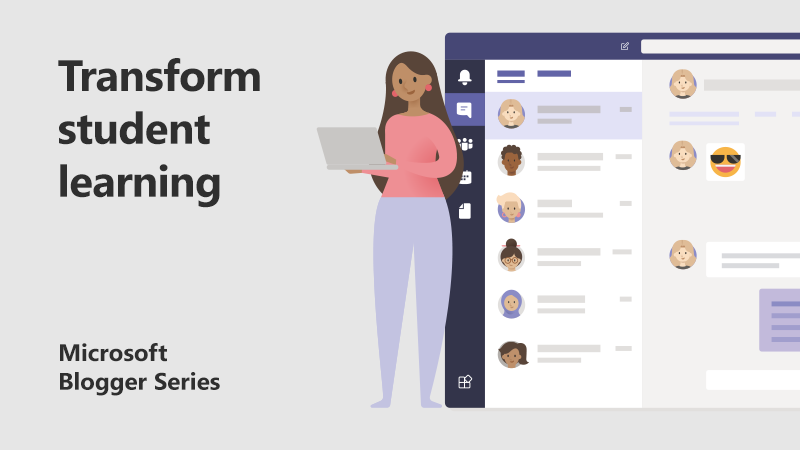
9 ways to transform the student learning experience with Microsoft Teams
Microsoft Teams has become one of the most rapidly evolving digital collaboration platforms of recent times. Usage across the education sector is now growing, with institutions starting to adopt Teams as their ‘go-to’ for teacher collaboration and communication. The next logical step, is to then look at how the student experience could really benefit from all that Microsoft Teams has to offer.
Working with academic colleagues at the University of Central Lancashire, we have been exploring the use of Teams with our students for just over two years now and have learned a lot throughout that time.
Here are some of the main ways that Microsoft Teams can transform the student experience based on learnings from our own journey.
1. Fuel collaboration
 Collaboration is vital to a student’s growth, helping them engage with subjects, improve inter-personal skills, and even become more creative. Microsoft Teams allows students to collaborate on documents together in real time whilst giving them the ability to engage in multiple forms of communication – from text, to voice and video conferencing. This helps them seamlessly trade ideas, leading to better, more informed work.
Collaboration is vital to a student’s growth, helping them engage with subjects, improve inter-personal skills, and even become more creative. Microsoft Teams allows students to collaborate on documents together in real time whilst giving them the ability to engage in multiple forms of communication – from text, to voice and video conferencing. This helps them seamlessly trade ideas, leading to better, more informed work.
2. Foster community
Teams actively supports the facilitation of organic student learning communities, where students can really start to grow connections with their learning peers. The nature of Teams means that, no matter where students are, they can come together as a group and support each other as they pool resources and knowledge.
3. Encourage social learning

It helps those who may not have an active voice in the ‘traditional classroom’, by allowing them the time to think and reflect before sharing their own views. These students are able to observe, and offer their own input in their own time, and in their own way.
4. Facilitate peer-to-peer support
The tech’s active environment encourages students to support and respond to each other’s queries and concerns – depending less on the academic team and increasing transparency across the group’s communication. Not only does this alleviate some of the pressure from faculty members, but also helps all students involved consider new ways of thinking about different topics.
5. Develop netiquette skills
Teams is a safe, digital space for students to start to develop their own professional online voice and presence. This can be particularly important before they begin participating in more public social arenas, such as Twitter. It’s almost like a training ground for what is and isn’t permissible online – and it’s completely secure, too.
6. Create an inclusive learning environment
Students access Teams using their university accounts – either via their own devices or their institution’s IT and library facilities. Its ease of usability encourages more out-of-hours and flexible working, fitting more easily around any other personal or work commitments. All a student needs is their phone and they’re instantly connected via the Teams app. This should make it less stressful for them, giving them more freedom to work their way and on their terms. Because great ideas don’t come strictly during working hours.
7. Help students take control of their own learning
In some cases, students are pro-actively setting up their own spaces for formative feedback and adding in their tutors as moderators. Simple polling features can allow students to voice what it is they would like to learn about or discuss next, as they start to really take ownership of their own learning. This is at the core of what learning, particularly in higher education, is about. Teams helps nurture this mindset, granting students the tools they need to own their work.
8. Provide a familiar learning environment
Teams can harness the often-familiar characteristics of contemporary social media platforms, but in a safe, private and professional environment. This can have a substantial impact on both raising and maintaining student engagement with the learning platform. There isn’t the fear of being ‘exposed’ and ‘open’ that comes from other social media platforms – and unlike those sites, Teams is designed to increase productivity and teamwork through a secure app, rather than feed into the vanity narrative.
9. Prepare students for the future digital workplace
Students are encouraged to develop a range of transferable, work-ready skills. One example of which, often includes their ability to effectively communicate and collaborate with others in online environments. As the modern workplace continues to evolve, with digital transformation at its heart, equipping students with the right skills is vital to everyone’s success – as individuals and as future employees.
Find out more
Moving from ‘learner management’, to learner autonomy and skills for the future
Microsoft Teams: Top 10 tips for learner engagement
How can technology support inclusive and participatory learning?
Cultivating collaborations with learner communities in Teams
 About the author
About the author
Chris is a Senior Learning Technologist in the UCLan TELT team, and digital learning lead for the University’s Faculty of Health and Wellbeing. He holds Fellowship with the Higher Education Academy and has completed a PGCert in Digital Education with the University of Edinburgh. Since 2018, Chris has led development of UCLan’s innovative and sector-endorsed “DigiLearn” model – to recognise and reward the inclusive digital practice of academic colleagues. Keen to widen collaboration across the sector, he established UCLan’s “DigiLearn Sector” – a community fostered to connect digital practitioners from across FE, HE and beyond. Chris is also an active member of the Microsoft, Jisc and ALT communities – regularly contributing to their respective blogs and presenting at various sector-level events. He is a lead contributor to UCLan’s own Technology Enabled Learning and Teaching blog, and has his own blog – #edtechthoughts. As a Microsoft Learning Consultant, Chris now works with other institutions – supporting their adoption of Microsoft technologies to improve both staff and student outcomes.




